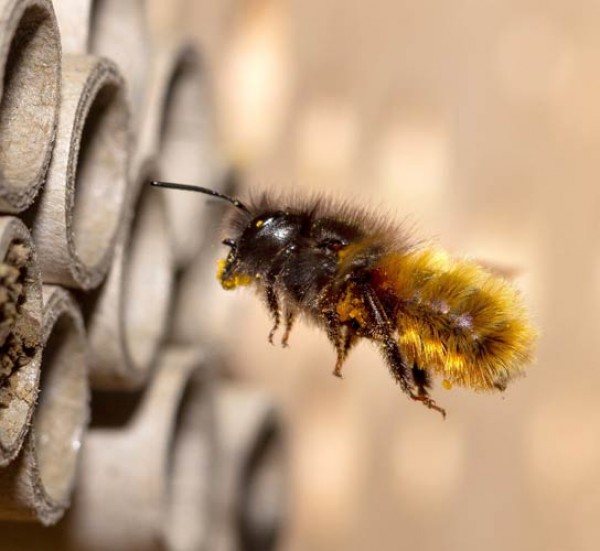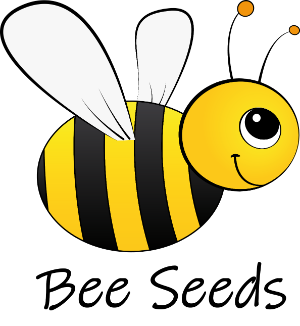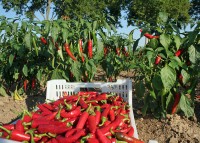
Bee-friendly Gardening
Wild Bees in the Garden
Besides the well-known honey bees, wild bees are also very useful in the garden. There are 585 species in Germany, most of which are now endangered due to the extensive use of pesticides and the increasing sealing of surfaces. Unlike the colony-forming honey bees, wild bees are mostly solitary bees. This means that the females build their nests and care for their brood without the help of conspecifics. They often depend on the pollen of certain plants. Some nest in the ground, others dig holes in wood or use already existing cavities or hollow plant stems, where they lay only one egg and provide it with nectar and pollen. After about a year, the offspring crawl out of the nests.
Valuable structures such as sandy paths, old hedges, unmown fallow land, dead wood or cairns have disappeared in many regions of Germany due to intensive agricultural use and increasing sealing of areas. Therefore, wild bees lack food sources and suitable nesting sites. Of the bee species included in the Red List (as of 2011), 52.2 % are already endangered.
What can you do in your own garden?
In order to promote wild bees, sometimes even small aids in the garden are enough. Bees need a high structural diversity, i.e. a bit of "wildness" in the garden, in order to feel at home. An English lawn, beds neatly covered with stones and peat mulch, paths edged with stones and the planting of evergreen exotic plants are fairly certain to kill wild bee populations.
Flowering offer for wild bees
It is important that bees can find nectar in the garden throughout the entire season, which means that there should be a variety of flowers available all year round. The flowers that are the most appealing to bees are those that have visible pollen or nectar that is easy to reach. You should consider reserving a least a small space to make a bee garden to help wild bees. There you can plant suitable food plants like wild flowers, flowers with unfilled blossoms, a flowering and fragrant herb bed with thyme, lavender, origanum and rosemary. It is also helpful to let one or two square metres of the garden go wild. For hedges you should consider flowering native shrubs such as wild roses, cornell cherry, blackthorn, elderberry or privet.
Wild bee species really appreciate the transformation of a few square metres of lawn into a flowering meadow. You can also leave a few islands of plants when mowing and only mow them twice a year. In time, a diverse flowering meadow will establish there. You can support this by sowing a flowering mixture.
In your perennial garden you should offer a wide variety of bee-friendly plant species. Early bloomers include pasque flower, bluecissus, buttercups and many crucifers, while summer bloomers include houseleeks, bellflowers, yarrow, night violets, mint, thyme, sage and oregano, comfrey, mullein, lavender, chickweed, mallow, spurge, mint, and as autumn flowering plants wall peppers, fennel, verbena, scabiosa, bluebells, unfilled asters, cinquefoil and purple loosestrife.
What`s nice about this is that wild bees don`t care whether you offer native European, American or Asian flowering plants, as long as they contain pollen and nectar that is easily accessible to them (avoid densely double flowers). You should also avoid conifers and evergreen species such as cherry laurel or bamboo. These cannot be used by wild bees.
Bee-friendly climbers are wisteria, wild vine, ivy, which flowers only in autumn, sweat peas and fence beet, which is the only food source for the fence beet sand bee.
There are also many species in the rock garden that are readily attracted to wild bees, e.g. wall peppers, viper`s bugloss, fieldman`s litter and the many different species of thyme. The open soil areas are often used as nesting sites.
Nesting Aids
Wild bees have a variety of nesting preferences. Many species nest above ground and can thus use insect/ and wild bee hotels.
In nature, they use cavities, forming brood chambers in hollow stems (of elderberry, thistle, blackberry, mullein, mugwort or cardoon), holes in dead wood, or other materials. Therefore, do not tidy up the garden too well after flowering in autumn. You can also easily make a nesting aid yourself by cutting the stems to about 10 cm, putting them in an old tin can and hanging them horizontally in sunny places.
However, most wild bee species nest in the ground forming burrows in loose soil, and if you want to promote a real diversity of wild bees, you should also provide a variety of suitable ground places in your garden.
One simple thing is to provide open ground. Narrow unplanted pathsides or an unused corner in the bed are sufficient for this. Avoid laying out gravel and crushed stone, because then the soil is no longer usable for the bees.
In a corner of the garden you can heap up a some loamy soil and cut off a vertical edge on the south side (sunlit) with a spade. This should be at least 20 cm high, better more. You will soon discover how this edge is colonised by wild bees.
A small sandy area also helps the wild bees. To do this, pile up 30 - 40 cm of sand on a square metre or more. It is best to use sand from the region, as the washed building sand from the DIY store is not so well accepted. Cats and dogs should be kept away.
An old wood stack in a corner of the garden also serves as a shelter for species nesting in the old wood.
Many bees also like to nest in the gaps of dry stone walls that face south.The stones should be stacked without mortar. If you then plant pollen-rich and drought-resistant flowering plants on the top of the wall, you have created a real bee paradise.
There are even wild bee species that nest in empty snail shells. To support them, you can lay out empty snail shells on a sun-exposed part of the garden. You can then observe the bees inspecting and moving into the snail shells in May and June.










